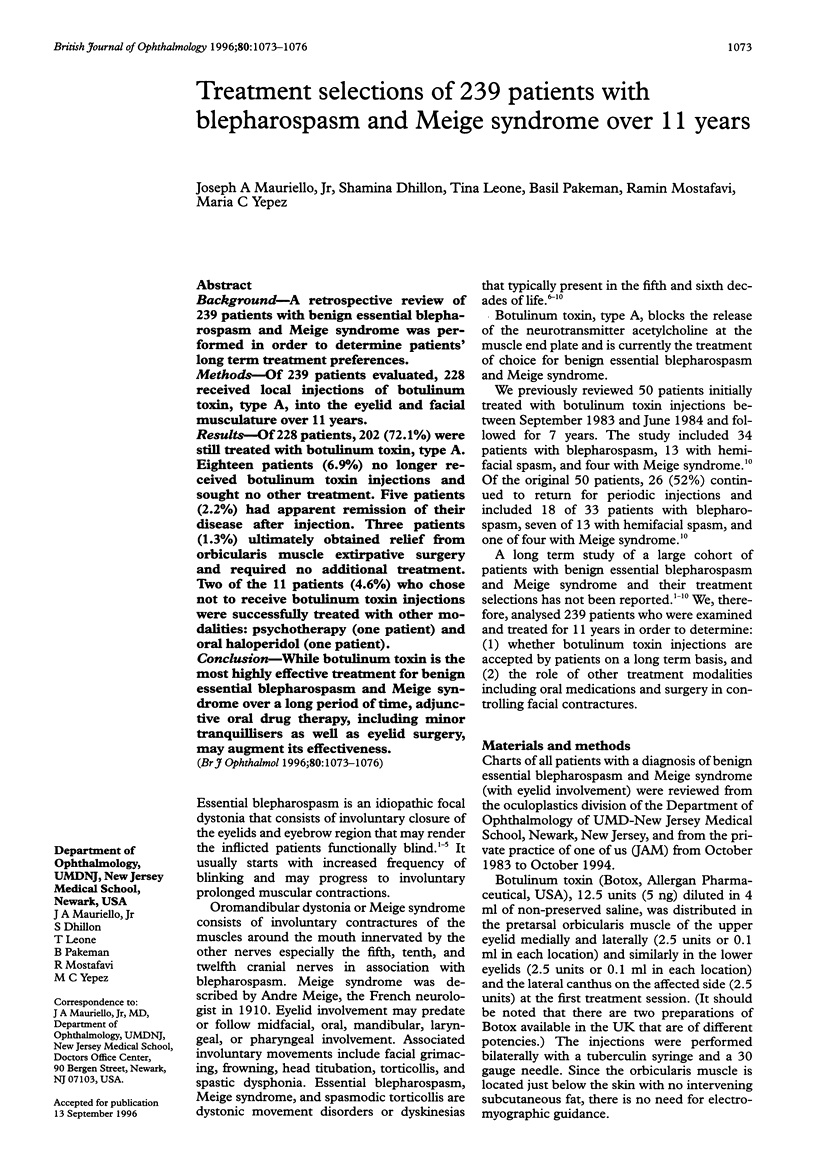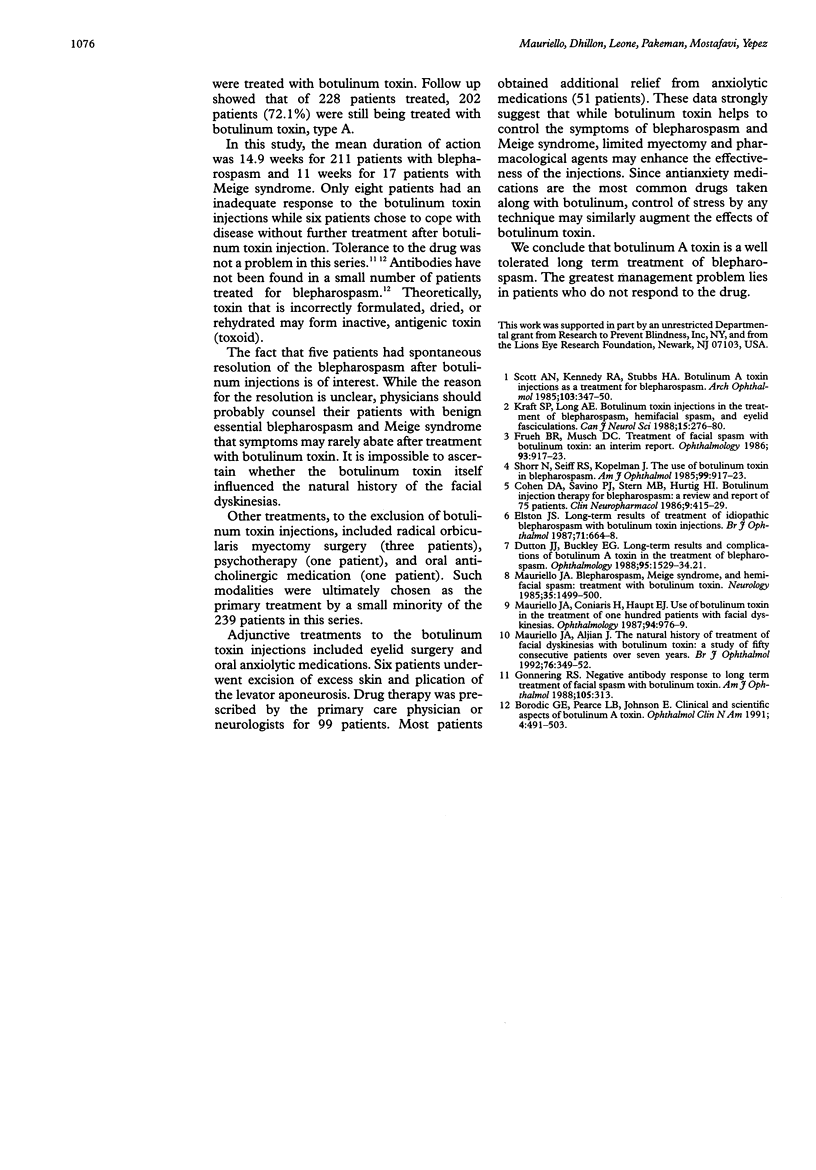Abstract
BACKGROUND: A retrospective review of 239 patients with benign essential blepharospasm and Meige syndrome was performed in order to determine patients' long term treatment preferences. METHODS: Of 239 patients evaluated, 228 received local injections of botulinum toxin, type A, into the eyelid and facial musculature over 11 years. RESULTS: Of 228 patients, 202 (72.1%) were still treated with botulinum toxin, type A. Eighteen patients (6.9%) no longer received botulinum toxin injections and sought no other treatment. Five patients (2.2%) had apparent remission of their disease after injection. Three patients (1.3%) ultimately obtained relief from orbicularis muscle extirpative surgery and required no additional treatment. Two of the 11 patients (4.6%) who chose not to receive botulinum toxin injections were successfully treated with other modalities: psychotherapy (one patient) and oral haloperidol (one patient). CONCLUSION: While botulinum toxin is the most highly effective treatment for benign essential blepharospasm and Meige syndrome over a long period of time, adjunctive oral drug therapy, including minor tranquillisers as well as eyelid surgery, may augment its effectiveness.
Full text
PDF



Selected References
These references are in PubMed. This may not be the complete list of references from this article.
- Cohen D. A., Savino P. J., Stern M. B., Hurtig H. I. Botulinum injection therapy for blepharospasm: a review and report of 75 patients. Clin Neuropharmacol. 1986;9(5):415–429. doi: 10.1097/00002826-198610000-00002. [DOI] [PubMed] [Google Scholar]
- Dutton J. J., Buckley E. G. Long-term results and complications of botulinum A toxin in the treatment of blepharospasm. Ophthalmology. 1988 Nov;95(11):1529–1534. doi: 10.1016/s0161-6420(88)32977-5. [DOI] [PubMed] [Google Scholar]
- Elston J. S. Long-term results of treatment of idiopathic blepharospasm with botulinum toxin injections. Br J Ophthalmol. 1987 Sep;71(9):664–668. doi: 10.1136/bjo.71.9.664. [DOI] [PMC free article] [PubMed] [Google Scholar]
- Frueh B. R., Musch D. C. Treatment of facial spasm with botulinum toxin. An interim report. Ophthalmology. 1986 Jul;93(7):917–923. doi: 10.1016/s0161-6420(86)33641-8. [DOI] [PubMed] [Google Scholar]
- Gonnering R. S. Negative antibody response to long-term treatment of facial spasm with botulinum toxin. Am J Ophthalmol. 1988 Mar 15;105(3):313–315. doi: 10.1016/0002-9394(88)90016-5. [DOI] [PubMed] [Google Scholar]
- Kraft S. P., Lang A. E. Botulinum toxin injections in the treatment of blepharospasm, hemifacial spasm, and eyelid fasciculations. Can J Neurol Sci. 1988 Aug;15(3):276–280. doi: 10.1017/s0317167100027748. [DOI] [PubMed] [Google Scholar]
- Mauriello J. A., DeLuca J., Krieger A., Schulder M., Frohman L. Management of traumatic optic neuropathy--a study of 23 patients. Br J Ophthalmol. 1992 Jun;76(6):349–352. doi: 10.1136/bjo.76.6.349. [DOI] [PMC free article] [PubMed] [Google Scholar]
- Mauriello J. A., Jr Blepharospasm, Meige syndrome, and hemifacial spasm: treatment with botulinum toxin. Neurology. 1985 Oct;35(10):1499–1500. doi: 10.1212/wnl.35.10.1499. [DOI] [PubMed] [Google Scholar]
- Mauriello J. A., Jr, Coniaris H., Haupt E. J. Use of botulinum toxin in the treatment of one hundred patients with facial dyskinesias. Ophthalmology. 1987 Aug;94(8):976–979. doi: 10.1016/s0161-6420(87)33337-8. [DOI] [PubMed] [Google Scholar]
- Scott A. B., Kennedy R. A., Stubbs H. A. Botulinum A toxin injection as a treatment for blepharospasm. Arch Ophthalmol. 1985 Mar;103(3):347–350. doi: 10.1001/archopht.1985.01050030043017. [DOI] [PubMed] [Google Scholar]


